

Qui sommes nous

Programmes et circuits

Célébrations

Courrier de nos amis

Un peu d'histoire

Dossier de presse

Contactez nous!

|
 |
Urban Cultours:
Dossier de Presse
|
| Jewish
Heritage Europe Conference in Krakow
Linda Jimenez
07/17/13

|
|
RADIO SEFARAD,
English Corner
When and where was Jewish Heritage Europe founded?
Dominique Tomasov is an architect based in Barcelona where she is
an active member of Reform Congregation Atid and a founder of Center
Zakhor of Barcelona, an organization which is specialized in the
protection and transmission of Jewish Heritage.
She recently attended a Seminar in Krakow, Poland, that was organized
by Jewish Heritage Europe. The title of the seminar was Managing
Jewish Inmovable Heritage in Europe, a working seminar on projects,
challenges and strategic thinking.
link
to interview
|
|
|
Jewish News ONE world's
Jewish-interest news channel
07/09/13
Standing over the city of Barcelona is the
medieval resting site of up to thousands of Jews, Montjuic.
Currently a plan is in place to try and mark out the exact
area of the site so as to stop further construction from happening
on top of the graves.
To try and date the origin of the cemetery,
Dominique was advised to search through property records to
find the first time the hill was referred to as Montjuic,
which means Mount of the Jews in old Catalán, the language
spoken in Catalonia.
|
|
Medieval
Jewish cemetery in Spain
Paul Walsh

|
|
|
|
Reencontrer les racines juives
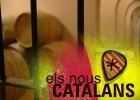 |
|
RADIO TELEVISIÓN
ESPAÑOLA
Jordi Vila pour a Antena 2 · 9/11/08
Elle est une des pionnières à expliquer l'histoire
du Call juif de Barcelone. En fait, Ville Comtal a fait que Dominique
Tomasov se retrouve avec ses racines.
Elle est aussi une des promoteurs du CentreZakhor de Barcelone,
specializé à la protection et transmission du patrimoinr
juif.
lien
au reportage - commence au min.15:17
|
|
Barcelona METROPOLITAN
the city's magazine in English - October 2008
In an effort to gain acknowledgement, the Jewish community united
and petitioned to have the Generalitat offi cially recognise the
cemetery,
and prevent future construction on the site. Due to their efforts,
in 2007 Catalunya recognised the cemetery as an offi cial landmark.
“We are not interested in vying with the city”,
explained Dominique Tomasov Blinder, an architect and Jewish heritage
advocate. “We want to work together, adding our expertise
as consultancy, to acknowledge the importance of this place to the
Jews and the city.”
|
|
Barcelona's
Jews
Roi Ben-Yehuda
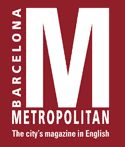
|
|
| The
Jews of Spain
Janet Levin
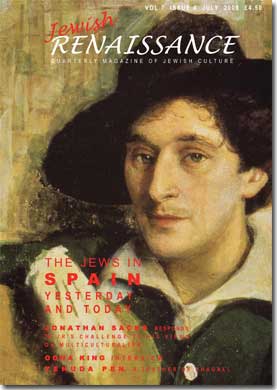
article
en anglais |
|
JEWISH
RENAISSANCE
quarterly magazine of Jewish culture, UK - July
2008
WHOSE HERITAGE?
Jewish heritage is now a major industry in Spain. Cities
cooperated to form a network of Jewish quarters –Caminos de
Sepharad– conservation is taking place and many festivals
and lectures are held, often without any Jewish participation and
sometimes with doubtful authenticity.
"I want to give a Jewish voice to the explanation of the Jewish
past – and to connect it with the Jewish present. Many in
Spain cannot see any connection."
Dominique told me that a campaign she had mounted with Israeli architect
David Stoleru had born fruit. A medieval Jewish cemetery in the
town was to have had a public toilet built over it. “It is
hidden from view but there are bones still there.” There were
petitions and much
pressure from the Jewish Communities and finally the Catalonian
government agreed that the site should have the status of a landmark. |
|
| National Geographic TRAVELER
December 2007
Still, I couldn't forget that Barcelona hadn't always been
a lovefest. There was the matter of the Inquisition and the
expulsion of the Jews in the 1400's. I'm not a very observant
Jew, but when I travel I gravitate to the ghettos and eerie
pockets of once flourishing-communities where crumbling remains
offer starck reminders of all that was lost. So I met up with
a Jewish architect, Dominique Tomasov Blinder, who started
Urban Cultours to give an inside look at Barcelona's former
Jewish quarter, or Call.
As we explored the tangle of streets in the Call, it became
clear that Blinder was on a mission. "This was one of
the most important centers of Jewish life until the late 14th
century. I believe the memory must be kept alive and given
a voice after 600 years of oblivion." She pointed to
Hebrew inscriptions in the wall of a medieval building. "These
tombstones were taken from the Jewish cemetery and used for
construction after the Jews were forced to convert to Catholicism
or flee the country." The streets of the Call
felt barren, more numbing abscence than presence.
|
|
Barcelona
two perspectives
Hugh Delehanty & Barbara Graham
 |
|
| Barcelona
restoring Jewish quarter -
but local Jews say they feel ignored
Reuven Friedman
December 14, 2006

|
|
JTA,
Global news service of the Jewish people
Dominique Tomasov, also an architect and a founding member of the
Reform congregation, independently began giving a Jewish voice to
guided tours of the neighborhood in the late 1990s.She tells visitors
the history of Barcelona Jews while tying it in to the re-emergence
of a living community. Tomasov spoke of fruitless efforts to build
some sort of partnership with the city around the renovation project.
“What upsets me most about this is that Judaism is a living
culture,” she said. “It has a presence in Barcelona,
and we could bring Jewish authenticity to the project.”
Various sources, including those in City Hall, said anti-Israel
feeling has affected the city’s attitude on some level. |
|
Let us take a look into the life of Dominique
Tomasov: we will have a better perspective of Judaism and Barcelona.
Born in New York,… almost immediately (her family) returns
to Buenos Aires, where she grew up and studied architecture…
We now have Dominique settled in Barcelona (since 1991), following
perhaps a mysterious mandate by Yaveh.
Being Jewish did not take a prominent place in
her life. But one day…
"I was invited to a family Shabbat… I liked it and repeated
the following Friday, and the next. In my case, there was a happy
coincidence between reconnecting with my roots, participating in
community life and discovering the Judaism of Barcelona… Step
by step I got more and more involved, I studied, until it was time
when I knew that I had to tell the Jewish story of this city from
my personal perspective as a Jewish woman in Barcelona".
|
|
Jewish
Barcelona
Sergio Makaroff
EL PAÍS, Spain
September 23, 2005
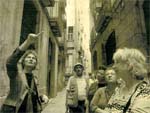
|
|
Sepharad
in Barcelona
Antonio Baquero
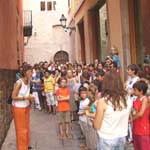 |
|
El Periódico
de Catalunya, Spain - September 5, 2005
A route in the Call becomes the “star of
the European Day of Jewish Culture”: "We are here
to explain a history common to all of us, Barcelonians and Jews."
Thus opened Dominique Tomasov the visit "to the story
of the Call", Barcelona’s Jewish quarter.
This woman, who combines her architecture profession
with the Hebrew heritage, lead the participants through the lights
and shadows of Sephardi Barcelona.
Her description and Catherine Favret’s story telling turned
the walk into a real discovery. The route was the main course of
the European Day of Jewish Culture, celebrated yesterday in Barcelona
for the third year and organized in 26 European countries the same
day. |
| NIW,
Niew Israelitisch Weekblad, Holland - January 21, 2005
The walks in the Call, the website and the study, take a lot of
her time; but Dominique Tomasov Blinder does not mind it “because
it gives me a lot of satisfaction.”
“Some time ago, Jewish North American visitors gave me this
advice: tell us the Jewish history of Barcelona, do not allow
this heritage to be lost….”
“I then realized that there was a very rich Jewish past here
but, on one hand the local Jewish community was shy and introverted
for a long time, and on the other the conversions had left very
deep scars… It is about not forgetting all of this.”
|
|
Our
own Barcelona
Mariano Slutzky
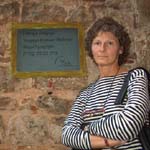
|
Back
to Sepharad
Robert Rosenblatt
JUDISK Kronika Sweden
November 2004
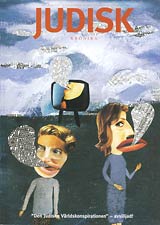 |
|
Dominique Tomasov Blinder found a Jewish
Barcelona that changed her life. Today, more than ten years after
her departure from a secularised life in New York, she is one of
the leader's of Spain's liberal Jewish community and has an opinion
in a lot if issues when it comes to Jewish culture.
The municipality of Barcelona is in a process of renovating the
old Jewish quarter and excavating the old Jewish cemetery on the
Montjuic (mountain of the Jews). However, the local Jews has not
been informed about any of this. “Our culture is taken
as something of the past, to be displayed in cases as interesting
objects for tourists.”
Jewish life in Spain is everything but free of problem but seems
to be on its way back again after more than 500 years of exile and
will probably give the country an additional attraction above the
beautiful churches and the dried ham.
|
|
In 1871, only 21 identified Jews were resident
of Spain and very few lived in Barcelona. As intermarriage is at
least 50%, ATID liberal congregation is the only place where a Jewish
person can participate with a non-Jewish partner. With the occasional
support of visiting Rabbis of the WUPJ, ATID was founded in 1992
by a dozen of young families who had been holdings services and
activities in the houses.
ATID became involved in the restoration of the historic synagogue
seven years ago, when Miguel Iaffa, a friend of the congregation,
bought the basement of a building identified as the mayor synagogue
in XIV c. documents. Thanks to a website launched by Dominique Tomasov
Blinder –member of ATID– and to her assistance, the
first bar mitzvah was celebrated there after 600 years.
“We really want to put Atid on the map for Jewish people all
over the world, so that they can share their experiences with us”
says Rabbi Edery. “Come and see us, meet our family of congregants.” |
|
Rebirth
in Barcelona
Schelly Talalay Dardashti
REFORM JUDAISM. USA - Spring 2004
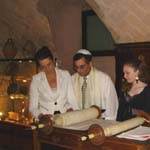
|
Barcelone
- la - Juive
Ann-Eve Fillenbaum
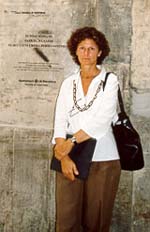
|
|
REGARDS,
Revue du Centre communautaire laïc de Belgique
Newsletter N° 3 - 4, Septembre 2002
Barcelone est grandiose, éblouissante
et multiple. Sous le rythme endiablé d'une ville qui ne dort
jamais, on trouve des siècles d'histoire, des jours de tragedies
humaines, surtout lorsqu'on évoque la communauté juive,
expulsée hors de ces murs comme du reste du pays lors de
l'Inquisition.
… Dominique Tomasov Blinder
est l'une des instigatrices de la redécouverte du passé
juif. Architecte de profession, elle a monté Urban Cultours,
à partir de "rien", grâce à sa passion
pour l'architecture et pour sa nouvelle ville d'accueil, stimulée
par la promesse faite à sa mère de ne pas briser la
chaîne du souvenir. Depuis 1997, elle conduit allègrement
les touristes à travers le Call, le vieux quartier juif de
Barcelone, leur relatant les us et coutumes d'un judaïsme d'antan.
Peu à peu, les espagnols, eux aussi, renouent avec ce chapitre
de leur histoire. |
The Sophisticated
Traveller, The New York Times Magazine
18 novembre, 2001
André Aciman enseigne la littérature
comparée au City University Graduate Center à
New York. La raison profonde de sa visite à Barcelone, “…
je suis venu rechercher mes racines juives en Espagne …”
Bien sûr, il ne reste que peu de vestiges de la vie juive
d’il y a 500 ou 1000 ans (même si de nouvelles traces
sont actuellement découvertes- comme les restes de l’ancienne
synagogue) et malheureusement André Aciman se sent un
peu déçu du résultat de sa recherche.
Lors d’une promenade organisée par Urban Cultours, devant
la maison de l’alchimiste, il dit:
… Je me suis surpris à rechercher
ce que j’imagine tout juif recherche en secret. Je ne suis
pas croyant, peut être ma démarche est elle déplacée,
cependant ma main continue à suivre le montant droit de la
porte, dans l’espoir de palper une veine dans le bois qui m’indiquera
le lieu d’une absente mezouza. Je sais que mon guide m’a
vu et a compris mon geste. Mais discrète, elle ne dit rien.
Je sais qu'elle sait. Je sais qu'elle sait. Je sais qu'elle sait.
… J'ai grandi avec tout cet héritage suranné
des convertis. |
|
BARCELONA
André Aciman
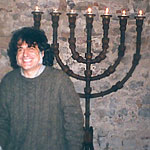
Menorah, Synagogue Schlomo ben Adret,
artiste Ferran Aguiló
|
| MERVEILLEUSE
BARCELONE
Lisa Alcaly Klug,
chroniqueur de voyage
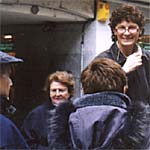 |
|
The Jewish
Week, hebdomadaire au service de la communauté juive
de New York. 26 octobre 2001
Lisa Alcalay Klug a suivi les circuits proposés
par Urban Cultours, elle a fait la connaissance d’autres visiteurs
et des membres de la communauté. Elle a assisté aux
offices du chabbat et été invitée au domicile
du Chabad avec d’autres visiteurs. Sa chronique montre son
enchantement.
Un guide qui, comme Dominique Tomasov Blinder,
parle parfaitement plusieurs langues et possède une grande
expérience, vous rend la «visite-promenade» des
plus interessantes. J’ai pu le constater et en profiter pleinement
lors de ma dernière visite à Barcelone, invitée
par la Chambre du Tourisme Espagnol et plusieurs autres organismes
de Catalogne.
|
|
Selon Mario Wainstein, pour bien connaître le Call
de Barcelone, mieux vaut être accompagné par un guide
spécialisé.
… si vous visitez le musée
de la ville situé Plaça del Rei, descendez jusqu’aux
ruines romaines et médiévales au sous-sol, et là, prêtez
attention. Parcourant ce fascinant musée, pratiquement a la sortie,
au moment de tourner sur votre gauche. Levez les yeux, vous découvrirez,
insérées dans le mur face à vous, des pierres avec des inscriptions.
Approchez vous et vous découvrirez qu’il s’agit d’une
écriture en hébreux.
… seul, sans l’intervention
de mon guide, Dominique Tomasov Blinder, je ne l'aurais jamais remarqué
… |
|
DÉCOUVERTE DE LA BARCELONE
JUIVE
Mario Wainstein,
redacteur en chef,
AURORA, Israël Octobre 2001
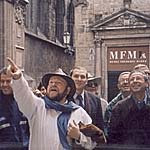 |
JEWISH BARCELONA
Silvia Riu,
rédactrice en chef,
Barcelona PLUS
Nº 15, Automne 2000
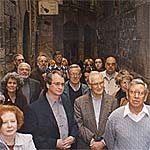 |
|
Silvia Riu et le photographe Dani Codina, avant d’écrire
cet article détaillé sur l’histoire de plusieurs quartiers
juifs, ont visité le Call de Barcelone, accompagnés par
Dominique Tomasov Blinder (Urban Cultours Project). Cet article, sur l’héritage
juif en Catalogne, est le premier du genre dans la presse locale depuis
de nombreuses années. Le style de Silvia Riu est un vrai plaisir
pour le lecteur.
… le dédale de ruelles
très étroites de l’ancien Call -le tracé du
quartier actuel est légèrement différent- forme un
havre de paix ombragé invitant à la promenade. L’étroitesse
des ruelles est telle, qu’à certaines époques de forte
densité démographique et pour pouvoir abriter les nouveaux
arrivant dans la communauté, le faible espace de façade
à façade a été comblé par des constructions
de fortune, rajoutées au niveau des étages, transformant
ainsi la rue en un véritable tunnel. |
| SPAIN et
BARCELONA À BILBAO
George Semler pour FODOR
Guides
Random House (dernières éditions)
… visites à pieds: les
meilleures visites guidées en anglais sur tous les sujets, de la
Sagrada Familia au Call, le quartier juif du Moyen Age. Contacter Dominique
Tomasov Blinder, Urban Cultours.
|
|
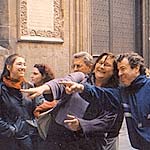
|
|
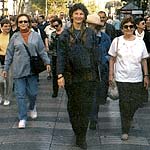
|
|
VOYAGES DES TEMPS PASSÉS
ET PRÉSENTS
compagnon de voyage sur les sites juifs d'Europe
Jeremy Leigh pour Guide UJIA, Londres
(en presse, 2001)
… A tous ceux qui ont l'intention
de visiter les sites juifs de Barcelone et du reste de l'Espagne-Sachez
qu'avec Urban Cultours, vous disposerez d'un grand spécialiste
du tourisme sur les lieux d'intérêt juif. Vous êtes
assurés d'un excellent service et d'une grande qualité.
Ce projet, organisé par Domique Tomasov Blinder.
|
|
TÉMOIGNAGES CACHÉS
D'UNE CULTURE IMPORTANTE
le Call, ancien quartier juif de Barcelone
Trudie Trox pour
MERIAN Classic,
Culture avec génie: Barcelone. 2002
… Les ruelles ne sont pas plus
étroites, les maisons ne sont ni plus majestueuses ni plus humbles
que dans le reste du quartier gothique. Le quartier juif de Barcelone
(Call, de l'hébreux "kahal": assemblée) a abrité
jusqu'à 4000 personnes au Moyen Age …
… Les empruntes juives
sont aujourd'hui plus que rares dans le Call. Urban Cultours propose
des visites (Anglais, Espagnol), d'un contenu historique et culturel
élevé … |
|
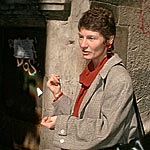
|
|
|
![]()
![]()
![]()
![]()
![]()
![]()
![]()
![]()




















